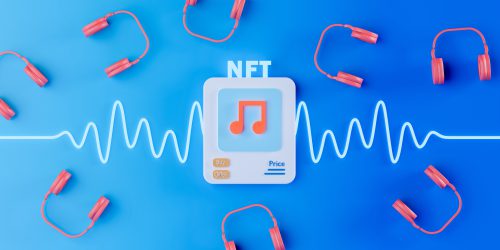 The music industry has undergone massive changes in the past twenty years. With streaming services overtaking CDs, music became available to the public at the cost of a monthly fee, which completely changed the way musicians made money off their music. When COVID-19 caused hard times for musicians, with nearly all touring canceled or at limited capacity, the use of cryptocurrency in this area offered a welcome and fast-growing opportunity.
The music industry has undergone massive changes in the past twenty years. With streaming services overtaking CDs, music became available to the public at the cost of a monthly fee, which completely changed the way musicians made money off their music. When COVID-19 caused hard times for musicians, with nearly all touring canceled or at limited capacity, the use of cryptocurrency in this area offered a welcome and fast-growing opportunity.
However, while we are now beginning to see the potential for NFTs to shape the future of the music industry, the use of NFTs in this context is still far from disrupting the current system of monetization of artworks.
What are NFTs?
In a nutshell, NFTs, or non-fungible tokens, are digital assets that are stored on a blockchain. Each NFT is unique (i.e., non-fungible) and cannot be replicated, making NFTs ideal for storing digital artwork, videos, and music. Because NFTs create “original” copies of these works, they also produce scarcity and value, just as is the case for the physical versions.[1]
That being said, when an artist makes—or “mints”—an NFT, they are writing the underlying smart contract code that governs the qualities of the NFT and adding those qualities to the relevant blockchain on which the NFT is managed. The smart contract (which is basically software code) tied to a specific NFT also indicates whether the owner of the NFT owns copyright to the underlying artwork—i.e., whether it allows unlimited commercial exploitation of the artwork underlying the NFT.[2]
To this end, it is important to understand that when someone purchases an NFT, they have not automatically purchased the underlying intellectual property rights to the piece of content tied to that NFT. The new owner of an NFT will acquire the IP rights of the underlying asset only if: (i) the author of the underlying work duly assigned all exploitation rights exclusively to the subject minting the NFT (if not the same person) and (ii) the smart contract attached to the NFT provides that all the exploitation rights to the work are transferred together with the NFT.
How have NFTs been used in the music industry?
Musicians are exploiting NFT-based technology in a variety of ways. For example, what makes NFT technology highly interesting to musicians is the fact that it can be coded in a way that also allows royalty payments to be made to the creator each time an item is resold in a secondary market.
Musicians are exploiting NFTs in two main ways based on whether or not the economic exploitation rights to the tracks underlying the NFTs are transferred to the buyers of the unique tokens.
Music Non-fungible Token as utility
To date, the most common use of NFTs in this industry is simply to embed a certain piece of content—an audio file or video, an album cover, signed merchandise, or other items—in a digital unique non-fungible token that can then be sold on a blockchain-based marketplace. This way, unless otherwise provided in the smart contract, the owner of the NFT has ownership of the digital token and the right of reproduction only for personal purposes—the same as owning a particular edition of a vinyl album. These NFTs can serve as a new form of collectibles, like the ones that fans can purchase at a concert to remember their experience or show their appreciation of a musician.
For example, the latest album by the rock band Kings of Leon was released as a collection of NFTs.[3] However, each owner of an NFT did not acquire IP rights to the album. Thus, the owners of these unique tokens will not be allowed to exploit the underlying tracks commercially (for example, by issuing licenses for public reproduction or for commercials); likewise, the NFT owners will not earn a penny from the royalties deriving from the success of the album on Spotify. Each will simply own an exclusive edition of the album they can resell on the digital market at any time as a collectible.
Backstage passes and meetings with stars can be attached to NFTs as well, something that cannot be done with vinyl. Utility tokens, such as those offered by the Spanish NFT marketplace Brots, can establish a deeper bond between musicians and fans, in addition to allowing the musicians to earn from NFT secondary sales.[4]
Music distribution on the blockchain
Another fascinating aspect is the possibility of distributing the music via blockchain platforms: this would really reshape the industry. The top music streaming platforms have hundreds of millions of monthly customers, yet money earned by musicians and producers remains marginal. Blockchain technology seems to have the potential to ease the industry’s woes. Its supporters maintain that decentralized technologies in music might represent a fair and transparent way to efficiently release music, streamline royalty payments, eliminate expensive middlemen, and establish a point of origin for music creators. In addition, fans and investors will be able to provide financial support to artists wishing to produce tracks/albums. In exchange, the investors will obtain shares of the royalties generated by those tracks.
However, this is more easily said than done, considering how the mainstream music industry works and the number of parties and entities that may eventually be entitled to copyright to a music track: authors of music and of lyrics, musicians playing on the track, producers, the label, and so on. Under Italian law, all of them might be entitled to receive compensation deriving from communication to the public, reproduction, and other forms of exploitation of a music project.
Thus, drawing up an NFT-based contract transferring all or portions of those rights requires reconciling all the various layers of rights connected to a certain music project and properly transposing those various rights in the smart contract attached to the NFT containing a music track. Musicoin, for example, is a Hong Kong–based music streaming platform[5] that supports the creation, consumption, and distribution of music in a shared economy. The company’s blockchain platform allows transparent and secure peer-to-peer transfer of music. Its coin, MUSIC, is a global currency that supports all trade surrounding music and music-related purchases. Musicoin eliminates the need for third parties, which means that 100 percent of all streaming revenues go to the copyright owner. Another example is Authorized Bootleg Community Records, which is creating a digital marketplace where users gain commercial rights to various tracks upon purchasing NFTs—allowing the owner to get exclusive rights immediately to use the music in their own social media projects. Likewise, Ditto Music launched the Bluebox suite aiming at migrating the royalty payment processes onto the blockchain.[6]
Apparently, music collecting societies are also interested in the potential offered by blockchain technology. For example, in 2021 the Italian collecting society SIAE announced the launch of “more than 4 million NFTs on Algorand for 95,000+ creators.”[7] This NFT project aims to “digitally represent the rights of the more than 95,000 SIAE member authors” by “digitizing these rights on a decentralized and transparent public blockchain.” This project seems promising on paper, but no further updates have been released since the first announcement.
Conclusions
Although NFTs are becoming a mainstream technology in the art industry, the particularly complex nature of the music industry makes it difficult to get the most from this technology in relation to the transfer and licensing of IP rights. However, before long new platforms will find solutions to all these legal complexities. Certainly, drafting the licenses in the smart contracts underlying these NFTs will require careful consideration and accurate due diligence.
[1] To learn more about NFTs, see Ethereum’s introduction to NFTs at https://ethereum.org/en/nft/.
[2] See Ethereum’s introduction to smart contracts at https://ethereum.org/en/smart-contracts/.
[3] See https://www.rollingstone.com/pro/news/kings-of-leon-when-you-see-yourself-album-nft-crypto-1135192/.
[4] To learn more about Brots’s services see https://www.brots.cloud/posts/nft-create-a-special-bond.
[5] See https://musicoin.org/.
[6] See more on this project at https://www.musicbusinessworldwide.com/ditto-to-launch-bluebox-blockchain-app-backed-by-1m-seed-capital/.
[7] Read SIAE’s press release here: https://www.siae.it/it/iniziative-e-news/siae-rappresenta-i-diritti-degli-autori-con-asset-digitali-creati-pi%C3%B9-di-4000000.


